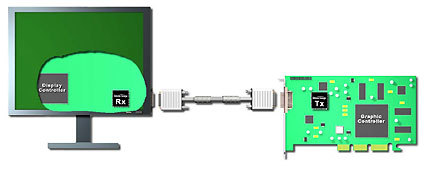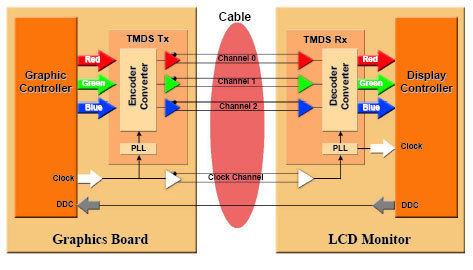The TFT Connection: Do NVIDIA and ATi Deliver?
The DVI 1.0 Standard
Today, practically every graphics card features at least one DVI connector, usually in the DVI-I version. This variant can also be used to attach analog VGA monitors using an adaptor. Most cards offer a combination of one DVI-I and one VGA connector. Two DVI-I connectors would be more sensible and more flexible as well, as they can be used for any connection type and in any combination of displays.
Because there are still cards that don't feature DVI connectors, many TFTs still come with a VGA connector as well. Understandably, this makes the production of such monitors more expensive. If a monitor features both connectors, DVI should always be given preference.
This block diagram shows the principle elements of the DVI interface. The signal travels from the graphics chip to the transmitter, then through the cable to the receiver in the monitor and finally to the display controller.
The DVI 1.0 standard divides the data transmission into three segments. These are the transmitter (the graphics card), the signal cable and the receiver (monitor).
The color of any pixel (picture element or dot on the monitor) consists of three components, namely red, green and blue (RGB). Each color component consists of eight bits of data, which allow for 256 shades of each of the three colors. As a result of these 256 shades per color, a full 16.7 million individual colors can be displayed.
The graphics chip generates the color information for each pixel as a 24 bit (parallel) data stream (8 bits per color). From this data stream, the RAMDAC creates the analog VGA signals. When this data is transmitted via DVI, the RAMDAC remains unused. Instead, the parallel data is sent to a TMDS transmitter, which transcodes the data into a serial signal. When the signal reaches the receiver - i.e. the monitor - the serial signal is then converted back into a parallel data stream. The conversion into a serial data stream is necessary because serial connections are much more interference-proof than parallel connections, especially over greater distances.
The block diagram details shows how the parallel color data makes its way from the graphics chip to the TMDS transmitter, where it is encoded into a serial signal and sent to the TMDS receiver in the monitor via the cable. In the monitor's TMDS receiver, the data is then converted back into a parallel data stream.
Get Tom's Hardware's best news and in-depth reviews, straight to your inbox.
-
Thanks for this. Saved me lots of trouble with (not) chosing an incompatible DVI cable for my monitor / computer connection.Reply

